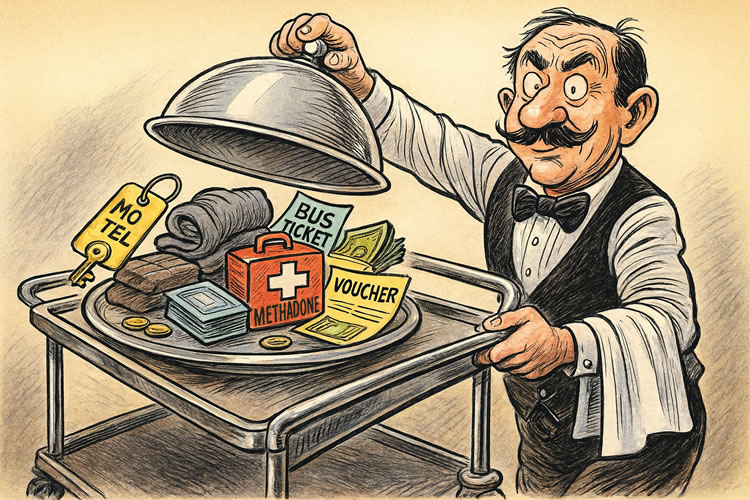Cross the border, say “ya’ can’t there from here,” and suddenly you’re a Vermonter. It’s a tongue-in-cheek description, but in some ways it reflects the legal reality. Two U.S. Supreme Court rulings—Shapiro v. Thompson (1969) and Saenz v. Roe (1999)—make it unconstitutional for states to impose waiting periods before granting welfare benefits to newcomers. Once someone sets foot in a state and declares their intent to remain, they are, for purposes of public assistance, a resident.
This means a millionaire in Arkansas who paid taxes there for decades could go bankrupt, move to Alabama, and instantly qualify for assistance—even though they’ve never contributed a dime to Alabama’s tax base. The Court’s reasoning was grounded in the constitutional right to travel and the Equal Protection Clause of the 14th Amendment.
For Vermont, this legal framework means the state cannot differentiate between someone who has lived here for 30 years and someone who arrived last week. But beyond federal law, Vermont’s own policies and administrative culture make it stand out among its New England neighbors.
The Unicorn: Emergency Motel Housing
The clearest example is Vermont’s emergency housing program. During the COVID-19 pandemic, the state dramatically expanded its use of motel vouchers to house homeless individuals and families. While most states relied on crowded shelters or left people on the streets, Vermont used federal and state funds to place people in private motel rooms with heat, bathrooms, and relative safety.
Even after federal emergency funding receded, Vermont continued to fund the program with state dollars. While Massachusetts operates a “right to shelter” law and New York City maintains a massive shelter system, Vermont’s approach offered privacy and dignity that was virtually unmatched. For people experiencing homelessness, it wasn’t hard to see why Vermont became a destination.
Proof of Residency: Vermont’s Ultra-Liberal Standard
Every state requires applicants to prove they reside there, but Vermont’s standard is notably low. Residency can be established through:
- Declaring an intent to remain.
- Obtaining a Vermont ID or driver’s license.
- Using a shelter or state office as a mailing address.
- Providing minimal supporting documentation like a letter from a friend or service provider.
By comparison, New York and Massachusetts often require leases, rent receipts, utility bills, or multiple official documents tying an applicant to a fixed address. Under Vermont’s statutes and regulations, Vermont’s Department for Children and Families (DCF) does not. Conversations with legislators confirm that DCF intake staff not only cannot consider how long a person has lived in Vermont—as federal law prohibits it—but they also do not record it for any planning or analysis purposes.
This isn’t just a consequence of federal law—it’s also a policy decision. And it leaves Vermont with a critical blind spot. Despite rising costs in housing and social services, the state does not collect data to show whether its housing crisis stems from longtime Vermonters losing homes or from an influx of newcomers drawn by the state’s benefits. Requests for this data from FYIVT and others have gone unanswered.
🍁 Make a One-Time Contribution — Stand Up for Accountability in Vermont 🍁
A Poor State Offering Rich Benefits
Unlike its neighbors, Vermont does not have the wealth of a Massachusetts or New York. The state’s per capita income sits at around $70,000, ranked 21st nationally, far below Massachusetts near the top. Vermont’s economy is small and rural, with limited job opportunities and few industries capable of generating high tax revenue.
Yet Vermont not only delivers federally mandated benefits—it layers additional state-funded programs on top. These include generous housing support, child health coverage through Dr. Dynasaur, heating assistance, and transportation subsidies. This combination creates a robust safety net, but it also raises hard questions about fiscal sustainability.
Without knowing how many recipients are longtime Vermonters versus new arrivals, policymakers are effectively spending taxpayer dollars without the information needed to make informed, targeted decisions.
A Harsh Reality Beneath the Surface
Vermont’s reputation as a “magnet” is amplified by its small population. With only 645,000 residents, even a few hundred new arrivals seeking assistance can have an outsize impact. In New York or Massachusetts, similar numbers barely register.
And while Vermont offers a softer landing administratively, its harsh winters, limited housing stock, and scarce employment opportunities mean life here is far from easy for anyone relying on assistance.
The Takeaway
Legally, Vermont cannot impose a waiting period on public assistance. But by not differentiating between new arrivals and longtime residents—even in its own data—the state has created a scenario where it may be inviting demand it isn’t equipped to sustain.
Layering state-funded programs on top of federal benefits, coupled with minimal residency requirements and unique offerings like motel housing, creates the appearance of an open invitation. Without data, legislators and taxpayers are left to guess whether Vermont is responding to a homegrown crisis or an imported one.
The question for Vermont isn’t whether newcomers have a legal right to assistance—it’s whether the state can afford to keep spending blindfolded.
Dave Soulia | FYIVT
You can find FYIVT on YouTube | X(Twitter) | Facebook | Parler (@fyivt) | Gab | Instagram
#fyivt #VermontPolicy #HousingCrisis #PublicAssistance
Support Us for as Little as $5 – Get In The Fight!!
Make a Big Impact with $25/month—Become a Premium Supporter!
Join the Top Tier of Supporters with $50/month—Become a SUPER Supporter!









Leave a Reply